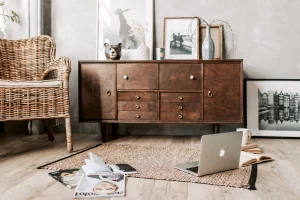
Wood is a natural material that visually brings warmth and cosiness to any interior design. Since most homes around the world have furniture made of wood, every homeowner needs to know how to properly maintain and clean those items. Even though wood is a durable material that has a long lifespan, it requires some special care, regular maintenance, polishing, and other TLC.
Wooden furniture, for example, needs to be dusted on a regular basis. Dust is abrasive and can scratch the gentle surface of the wood, causing microscopic dents and cuts that will attract soil, grime, and other dirt. When dusting, it is best to use a damp microfiber cloth – that will prevent loose dust from flying around. However, make sure that the cloth is slightly damp and not dripping. Excess moisture can cause water damage or water stains.
Whenever food or drinks spill on a wooden surface, clean them immediately. Any spilled liquids left to sit can cause discolouration or wrapping of the wood or make its finish cloudy. Dust on a regular basis, such as every few days or at least once a week, to keep dust buildup to a minimum. Dusting removes the small particles that can scratch the surface. Once a month, use your favourite furniture polish(or make your own) to bring the shine back to your wooden furniture. Buff out minor scratches or nicks.
Too much polish or wax can dull the wood or cause it to become cloudy, or faded. Depending on how frequently you polish the furniture, it will eventually require a thorough cleaning once in a while. Both methods we mention below are effective. Begin with the gentler method of using a tea solution, and if that fails, move on to the more potent method of using mineral spirits.
Regular cleaning of wooden furniture
- Wipe spills as soon as they happen – If liquid spills on the wooden surface, grab a microfiber cloth or a paper towel and clean it up as soon as possible. If something sticky leaves a messy spot on the wood, dampen a cloth with plain water (make sure it is slightly damp and not dripping) and gently scrub at the stain. Once you remove the liquid, buff the surface with a dry microfiber cloth.
- To remove dust, use a microfiber cloth, a feather duster, or an electrostatic duster. If you are sensitive to dust, wear a dust mask and consider dusting with a damp cloth rather than a duster. After dusting, buff the surfaces with a soft cotton cloth to remove smudges and bring back the original shine. Don’t forget about the legs, arms, and smaller wooden supports on the furniture.
- If you have not cleaned your wooden furniture in a while and it has become grimy, mix a cleaning solution of 1 teaspoon of dishwashing liquid and 2 litres of water in a bucket. Dip a cloth in the solution, wring it out until it is damp and not dripping and gently clean the whole surface of the wood.
Deep cleaning of wooden furniture
If you have been using too much wood wax or have not cleaned your wooden furniture in a while, it is possible that a sticky residue will develop all over its surface. To get rid of it:
- Make a tea-cleaning solution – Tannic acid, or tannins, in tea can cut through waxy build-up on wood. In two cups of hot water, steep two black tea bags. When the tea is cool enough to handle, soak a soft cloth, cotton balls, or cotton swabs in the solution and wring it until it is slightly damp. Begin at the top and gently wipe in the direction of the wood grain. To remove the grime, rinse the cloth in cold water. Wring and rewet with the tea solution, then wring and keep wiping. Finish by buffing each cleaned section to a shine with a soft cloth.
- Mineral spirits is a petroleum distillate that is used to thin oil-based paints as well as to clean stains and varnishes to remove waxy build-up. When using the product, always work in a well-ventilated area and wear protective gloves. Apply a small amount to a cloth and wipe the furniture in the direction of the wood grain. As the grime is transferred, move to a clean area of the cloth. Buff the wood with a soft microfiber cloth.
Make sure you wax or polish your wooden surfaces once in a while. Wax is more durable than spray products and will give a hard protective layer that will prevent minor scratches, staining and water damage. Liquid finishes are easier to apply, however, their protective layer is not as thick and efficient.
If you have an expensive or antique piece of furniture, it is best to bring it to a professional. Any attempts on cleaning it by yourself may cause damage to the surface or harm the wood.
